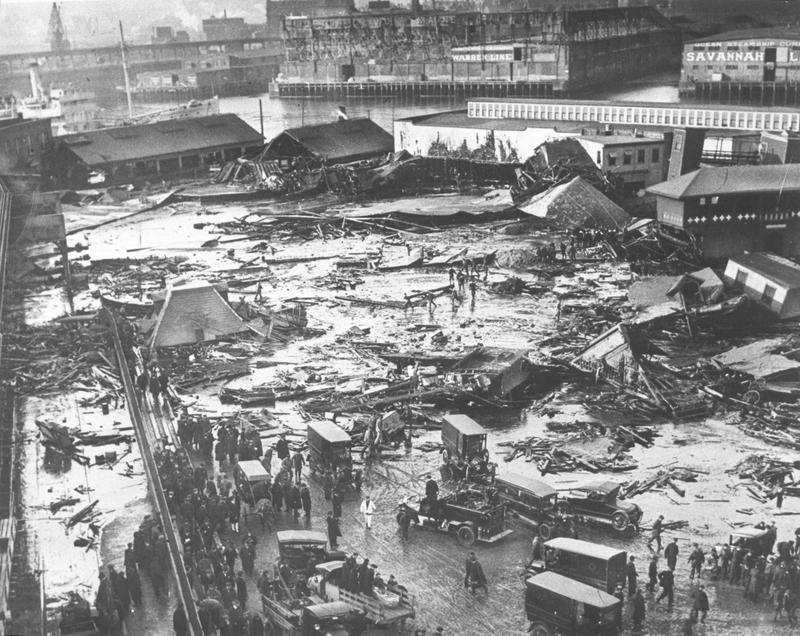The Great Molasses Flood: Sabotage or Industrial Accident?
By | August 2, 2018

An unfathomable tragedy filled the streets of Boston with a tsunami of molasses…yes, molasses!...on a balmy January day in 1919. The 2.3 million tons of the sticky, brown molasses moved surprisingly fast, destroying several buildings, ripping an elevated train from its tracks, and killing 21 people and multiple horses. What became known as the Great Molasses Flood occurred when a giant holding tank at the Purity Distilling Company, which had just been filled with molasses, burst apart. The owners of the Purity Distilling Company claimed that a bomb placed by “evilly disposed persons” was responsible for the flood. Could it have been an act of foreign terrorism or a structural failure?

A Loud Noise and a Wall of Brown
Temperatures were especially warm for January…over 40-degrees. People were out and about, enjoying day. Just after lunch time, at about 12:40 in the afternoon, a sudden, loud, metallic sound rang out and the ground shook. The people of Boston had little time to ponder the strange noise; a 15-foot tall wall of brown, bubbling molasses barreled down on the city at 35-miles per hour. People and horses were swallowed up by the brown wall. The force of the molasses crumpled several buildings and pushed others off their foundations. Electrical poles snapped, as did the steel supports of the nearby elevated train platform. The train was upended from the tracks.
In the molasses tsunami’s wake was a half a mile of destruction…splintered houses, dead bodies, injured horses, and buried carriages. The Boston Post printed an eye-witness report of the time saying that, amid the waist-deep sludge, he could see living creatures struggling to free themselves from the thick, brown muck, but that it was impossible to tell if they were humans, dogs, or horses.

Soldiers Rushed to Help the Police and Firefighters
The USS Nantucket, a training ship, was docked nearby and the soldiers on board witnessed the disaster. They rushed to the scene to help, pulling victims from the goo. They were soon joined by Boston police and fire departments. Their rescue efforts were hampered by the nature of the flood. The molasses, which had been hot when it was poured in the holding tank, was thin and more fluid as it flooded the streets, but now, the cooler temperatures were causing the molasses to thicken to a near-solid state. Victims encased in the cooling molasses had little time before they suffocated.
Firefighters turned their rescue efforts into saving their fellow firefighters. The Engine 31 firehouse was close to the molasses tank and was knocked off its foundation by the flood. The second floor of the station collapsed, trapping a group of firefighters who were eating their lunch at the time. Rescuers spent hours cutting through the ruined building to reach the trapped men. They were able to rescue all but one of their brothers, who drowned in the sticky molasses.
In all, 21 people died in the molasses flood and more than 150 people were injured. In the days after the flood, periodic shots rang out as clean-up crews euthanized trapped horses. Some victims were not chiseled out of the molasses for days. Some were unrecognizable.

Finger-Pointing Started as Soon as Clean-Up Did
Clean up crews immediately went to work shoveling the thick, brown sludge from the streets and rebuilding the destroyed structures. They used salt water from Boston Harbor to scrub the affected areas and the newspapers reported that the Harbor was stained brown for six months after the accident. The molasses seeped into the smallest cracks. One witness reported, “Everything a Bostonian touched was sticky.” Residents claimed they could smell the sweet molasses every summer for years.

The United States Industrial Alcohol (USIA), the overseer of the Purity Distilling Company, was quick to deflect the blame for the flood. Officials from the USIA noted that about 80% of the molasses they produced was used for making munitions and gunpowder. They claimed that foreign, likely Italian, anarchists had planted a bomb in the holding tank as an act of sabotage. In fact, they reported that they had received a menacing phone call just one year earlier from an individual who threatened to blow up the tank.
As the lawsuits stacked up against USIA and Purity Distillery, experts examined the holding tank. They found that the tank, which had been filled to capacity just before the flood, suffered from a severe catastrophic structural failure, causing it to burst apart at the seams. Curiously, the tank was not normally filled to capacity, leaving many to speculate that the company was ramping up production with plans to sell the excess molasses to rum-makers as a precursor to Prohibition, which was scheduled to go into effect the following year.
Flood victims filed 119 lawsuits against the company. Legal proceedings dragged on for five years, but in the end, the courts ruled that USIA had to pay flood victims and their families $628,000 in damages, about $8 million by today’s standards.

